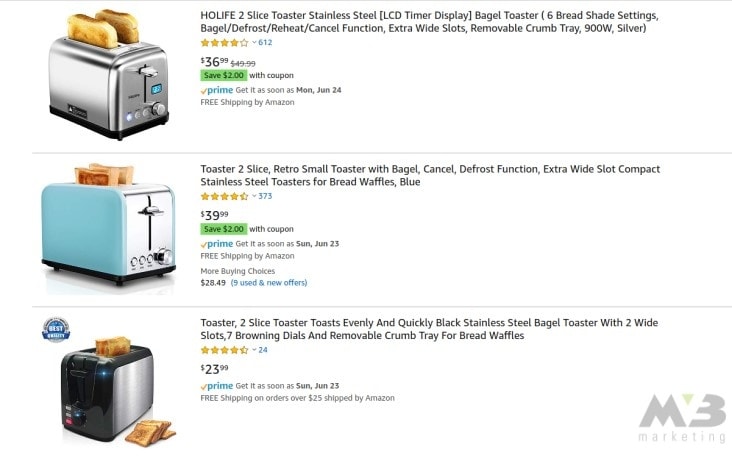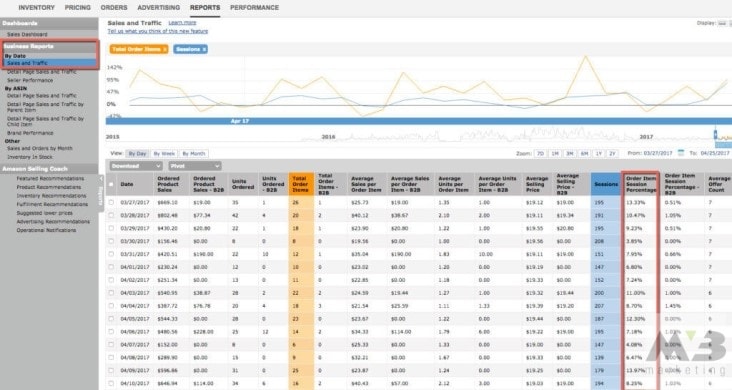Amazon SEO Secrets
Amazon doesn’t use the same SEO algorithm as fellow search giants Bing or Google. Instead of the 200 or so factors that go into Google’s system, Amazon’s A9 algorithm instead considers two things:
- 1. The RELEVANCE of the product in question, and
- 2. that product’s PERFORMANCE.
How Does Amazon SEO Work?
Once upon a time, Amazon reached out to the originally unaffiliated A9 company when the company’s engineers first began to index products similar to Google search results. Now, A9 is both a subsidiary of Amazon and the name Amazon has given to its SEO algorithm.
The modern A9 algorithm has a retrieval time of 212 milliseconds, where it sorts through all of Amazon’s listings to find the most appropriate match for a user’s search.
What Does All That Mean for Your Business?
By breaking your SEO factors down into “relevance” and “performance,” you’ll be able to craft killer product pages and boost your Amazon SEO rankings in no time.
START HERE: Learn Amazon’s SEO Factors
The best place to start engaging with Amazon’s SEO factors is with the platform’s categorization system. This system provides consumers with accessible segmentation features that you must play into if you want your products to appear in frequent searches.
Amazon’s system highlights the following aspects of your products:
- Product category
- Seller rating
- Shipment method
- Brand
- Color
- Product condition

You’ll need to touch upon all those when creating your product pages. Focus on the following elements first:
- Keywords: SEO keywords are especially easy to research on Amazon, and they help differentiate your product from similar ones that competitors have created.
- Nodes: Amazon’s individual categories are numbered with specialized ID numbers or nodes. You can find your products’ nodes in the URL of your chosen Amazon category. While you can’t integrate keywords, backlinks, or other SEO elements into node optimization, you should be aware of your categorical node when altering your image alt text for SEO optimization.
- Brandtextebin: This Amazon SEO element pits your product’s performance, or sales record, against similar products in its same nodal category. This comparative performance operates almost like CTR and bounce rate, and it tells Amazon how successful your product is, how much consumers like it, and whether the platform should promote it.
Amazon SEO Secrets # 1: Research Your Product’s Keywords
Keywords are single words or extensive phrases that users type into search bars to find their content. These keywords can be specific and vary by industry. Using a keyword research tool will help you identify which keywords are most commonly used in your category of business.
You can find industry keywords with:
- Google Trends: Shows an incredible amount of detail about keyword trends by date and location
- Google Search Console: Tells you which keywords are already sending traffic your way
- Answer the Public: Mines Google Keyword Planner and Google Autosuggest to provide common user questions in easy-to-interpret visualizations
- Adword Keyword Generator: Generates keywords and related key terms, which is great for local SEO
- KWFinder: Specializes in long-tail keyword research
Google Chrome also offers free extensions such as Wordtracker Scout and Keywords Everywhere that’ll help you create stronger content.
Amazon SEO Secrets #2: Create a Category-Specific Seller Name
Your seller name has SEO potential. If you sell a specific product in a specific industry, make sure that your seller title reflects that specialization.
- Click “Sell on Amazon”
- Click “Start Selling”
- Create an Amazon Prime account, or log in
- Enter your legal name into the prompted box
- Enter your business’ address, if applicable
- Create a unique seller name
Amazon will let you know if your name of choice is already in use. Embrace your creativity for this stage, but make sure your name includes short, memorable SEO keywords and reflects the interests of your industry.
Amazon SEO Secrets #3: Optimize Your Product’s Title
With Amazon’s filters and essential SEO elements in mind, you need to carefully craft the title of your product.
Your product title should:
- Include the name of your brand to ease filter crawlers
- Describe your product’s outstanding features concisely
- Highlight unique product features
- Note your product’s coloration and size
- Note product quantity and availability
Product titles need to be keyword-heavy to attract Amazon’s filters. That said, don’t keyword stuff your product titles. These titles need to be concise and informative, as well as SEO-oriented.

Read your chosen title several times before publishing a product to ensure that you’ve spent time considering the quality of the title, as well as its keyword quantity.
Amazon SEO Secrets #4: Load Your Backend Keywords
You’ll be able to integrate invisible keywords – backend keywords – into your Amazon Seller Account through the account’s backend section. These keywords communicate directly with A9 to list your product effectively.
To access Amazon’s Backend Keywords:
- Log in to your Amazon Seller Central Account
- Click the “Inventory” tab
- From your list of active products, click “Edit”
- In “Edit Product Info,” move away from the “Offer” tab and onto the “Keyword” tab
- Enter your chosen backend keywords into the “Search Terms” section
Backend keywords through Amazon are limited to 250 characters. Avoid unnecessarily repeating your keywords, as repetition won’t boost your SERP ranking. You’ll also want to avoid using your brand name as a backend keyword.
Instead, utilize popular abbreviations for your product and synonyms that could also be used to describe what you’re selling.
Amazon SEO Secrets #5: Craft a Valuable Product Description
Your product description is your primary source of product copy on Amazon. It needs to be readable, natural, and SEO-rich. After you’ve researched your appropriate keywords, interweave them with informative text describing your product’s:
- Dimensions
- Features
- Ingredients
- Benefits
Utilize bullet points to make your product description more readable. Bullet points are also ideal for highlighting your chosen keywords.
Amazon SEO Secrets #6: Set Your Prices with SEO in Mind
The amount you charge for your product changes the way Amazon interprets your product’s success, as well as your Amazon conversion rate.
Amazon’s conversion rate reflects the number of consumers who purchase your product. A higher number will result in a higher SERP ranking. You can find your rate through the following means:
- Click the “Reports” tab
- Go into “Business Reports”
- Click on “Sales and Traffic”
- Your conversion rate will be listed as “Order Item Session Percentage”

You can break these percentages down further by assessing them by ASIN. In the column on the left-hand side of the page, click “Detail Page Sales and Traffic by Parent Item” for a more accessible conversion rate.
You’ll need to consider your conversion rate alongside your monthly profit to understand whether your rate is positive or negative. If you have a notable profit and a high conversion rate, you’re making a significant number of sales to the result of good profit. A high conversion rate partnered with low profit means that while you’re succeeding in a number of sales, your business isn’t attracting significant consumer attention.
If you don’t price your products on Amazon responsibly, you risk lowering your Amazon search ranking. Keep your price in the same range as those of your competitors, with liberties taken for the cost of production.
Amazon SEO Secrets #7: Create Amazon-compatible Product Images
Your product images should be 1000 pixels or larger in height or width to comply with Amazon’s quality standards. By creating images of this size, you enable your consumers to zoom in on your products. By crafting high-quality images and complying with Amazon’s professional standards, you let Amazon’s crawlers know that your business is professional.
You can further the SEO value of your images with strong alt tags. Alt text describes the content in your image. You can integrate keywords into your alt text, but it should primarily serve as an information-rich description of your image that users can access while on mobile or in the case of a loading failure.
You can customize your alt text using the following HTML code:
<img src=https://www.amazon.com/uploads/image.jpg alt=”YOUR ALT TEXT HERE”>
Amazon SEO Secrets #8: Court Strong Amazon Reviews
Finally, once you’ve published your product, you’ll want to generate a number of descriptive reviews. Amazon reviews have a notable impact on your product’s CTR and generate consumer trust. The more reviews your product has, the more sales you’re likely to make.
Encourage your audience to leave reviews by offering them coupons or other incentives. You can also email previous buyers to encourage them to leave a review after making a purchase.
Want to Supercharge your Amazon Conversions? Try MV3.
Do you want your products to catch A9’s eye? Hire MV3’s team. Our professionals are here to help you better understand Amazon’s algorithm, create valuable content, and facilitate strong backend keywords. We want you to grow your revenue stream and boost your business’ sales because we’re not happy until you are.
Conclusion
Is your company in need of help? MV3
Marketing Agency has numerous Marketing experts ready to
assist you. Contact MV3 Marketing to
jump-start your business.


